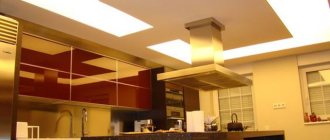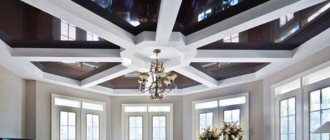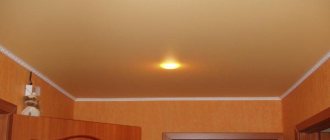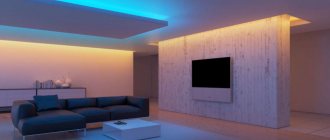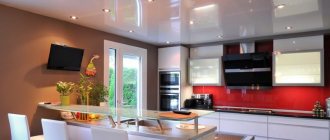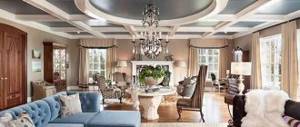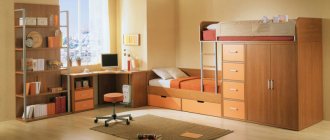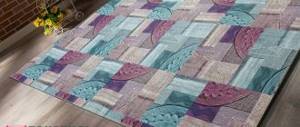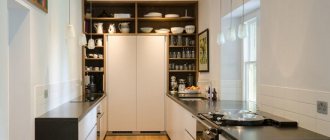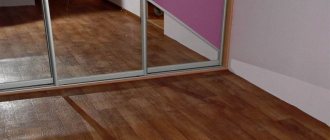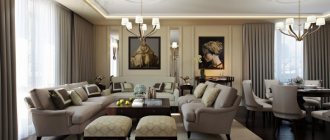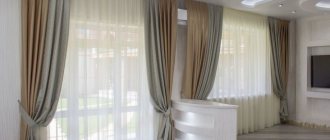Disadvantages of suspended ceilings in an apartment
In recent years, there has been a real boom in suspended ceilings.
It would seem that ten years ago the material was known mainly in Europe, but today it is the most popular and fairly cheap way to decorate the ceiling space. But despite many practical advantages, suspended ceilings in an apartment also have disadvantages. Stretch ceiling
- a kind of film fabric made of high-strength polyvinyl chloride, stretched over the entire ceiling area and secured with a baguette. The thickness of the PVC film ranges from 0.28-0.5 mm. The ceiling is produced in widths from 1 to 3 m.
An undoubted advantage is the simplicity and speed of installation. In order for the fabric to acquire working elasticity, it is heated using a heat gun and directly fastened. As a rule, the installation of suspended ceilings is carried out by specialists.
There is another type - fabric. It is made from nylon or polyester threads impregnated with polyurethane glue. The width can reach 5 m with a thickness of only 0.25 mm. In most cases, the material is much more expensive than film ceilings and is installed according to a different principle. No heating of the canvas is required.
Ceiling space design
The high quality of the polymer base of the chintz ceiling allows you to apply a patterned surface relief without resorting directly to photo printing. The texture is applied to vinyl wallpaper in the same way.
But, unlike modest wall decor, stretched canvas looks quite expressive and impressive. This is one of the reasons why chintz stretch ceilings, photo, are in high demand, despite fierce competition from fabric and satin materials.
If you need to decorate the ceiling surface, for example, in a hall or living room, then the best choice is a simple white panel on which a film photographic image is pasted. The quality of adhesion of the film to the ceiling canvas is very high, so there is no need to worry that the image may peel off. Moreover, the presence of holes in the canvas guarantees the absence of air bubbles, even if you try to paste the picture with your own hands.
About negative factors
The disadvantages of suspended ceilings are few and mostly structural, but, nevertheless, the buyer should be aware of them.
Limited width
As noted above, the standard width of the canvas is 1-3 m. It is good when the width of the room falls within this interval. If the room is large, then the installation of suspended ceilings will be done by “stitching” two sections together. The joint is especially noticeable on glossy surfaces, which will not only negatively affect aesthetics, but will also become the main “weak” point of the entire structure. This is due to the likelihood of a rupture from water or simply under the influence of temperature changes. To eliminate the possibility of the formation of noticeable cracks and tears, you should give preference only to high-quality PVC films or fabric.
Temperature instability
Operation is allowed only in stably heated and warm rooms. That is, if the finish is in an unheated room during a cold period, then the film is more likely to crack. Not only negative, but also positive temperatures can damage the ceiling. In particular, the material is susceptible to melting from lighting fixtures, so you should find out the maximum permissible power at which PVC will remain intact.
Advantages of chintz ceilings
The main advantage is the ability to create seamless structures. Thus, a single piece of chintz used to cover the ceiling can reach 5 meters in width, while fragments of PVC film should not exceed 2 meters.
The second obvious advantage is the resistance of chintz to high and low temperatures.
On the one hand, this allows you to use lamps of different power for lighting. For comparison, this parameter when using PVC film could not be more than 40 W. On the other hand, the installation of chintz stretch ceilings can be done at sub-zero temperatures, and the room does not need to be heated to level them.
But the main feature of a satin ceiling for many is the opportunity to implement unique design solutions.
Calico stretch ceilings
Calico stretch ceilings are a relatively new phenomenon for our country. But our company can offer this type of ceiling to its clients. And what is a “calico stretch ceiling”, we will now look in more detail.
Calico stretch ceilings, or as they are also known, satin ceilings, are a canvas made of PVC film, but with a peculiar micro-relief or perforation. Therefore, we can safely say that a chintz stretch ceiling is something in between a regular stretch ceiling made of PVC film and a fabric ceiling.
The popularity of such ceilings is due to the fact that they have many advantages:
- Unlike ceilings made of PVC film, chintz ceilings “breathe”. Therefore, they are considered more suitable for installation in children's and bedrooms.
- To install such ceilings, it is not necessary to warm up the room; this allows you to install them without removing furniture and other non-transportable items, the main thing is to free up access to the walls for the craftsmen.
- Durability is also a distinctive feature of chintz stretch ceilings. The prices for repairing or replacing film ceilings are, of course, not very high, but they are still an unpleasant expense.
- Light transmission is one of the brightest and most memorable advantages. Without being transparent, these ceilings allow light to pass through, scattering it a little and creating interesting effects, which is why designers are so fond of chintz stretch ceilings. We are sure that you will also like photos of our works.
- Such ceilings do not attract dust and do not accumulate it, so they are very easy to care for.
- The large width of the canvas, up to 5 meters, allows you to make seamless chintz stretch ceilings. The prices are somewhat more pleasant than those of fabric ones.
- Their resistance to temperatures allows the use of a larger range of lighting devices for lighting, as well as the installation of such ceilings in rooms without heating.
- There is a large selection of colors and it is even possible to put a photo image on it.
- Semi-matte surface. Being, in terms of reflectivity, between matte and glossy ceilings, chintz stretch ceilings also keep their prices in this range.
- The durability of these ceilings also deserves attention. They do not sag, fade or crack. And their service life significantly exceeds the 10-year warranty period.
Myth #1: Fabric ceilings are made from natural fabric
The word “fabric” simply makes us believe that this is, indeed, a piece of natural canvas or just some kind of dense cotton material.
And, naturally, this creates the illusion that the ceiling will be incredibly environmentally friendly and almost with a natural aura... But everything is not so rosy.
They are called fabric because of the technology by which they are made. They are literally woven from threads, but they are not natural! The thread for fabric ceilings is made of polyester, which means that it does not smell of natural ingredients.
But, on the other hand, there is nothing wrong with this. The same faux fur and many other fabrics for clothing also consist of polyester. And nothing, so far no one has died from this.
In addition to the fact that the thread for ceilings is not natural, they are also impregnated with a special polymer composition based on polyurethane. This is necessary so that the ceilings are resistant to light and water.
That is, as you understand, there is nothing environmentally friendly about them except a loud name. Therefore, if this factor was decisive for you, then it is worth reconsidering other options.
Comparison of PVC and fabric stretch ceilings
Fabric and PVC ceilings differ from each other already at the stage of composition and production. To create PVC fabrics, as the name implies, polyvinyl chloride, various temperature regulators, pigments and other synthetic elements are used. The mass is heated, mixed to a homogeneous consistency and rolled out into a thin sheet using a special machine. Fabric ceilings are made differently; they are literally woven from polyester thread, and then impregnated with water-repellent polyurethane. The quality of the material used in both cases depends on the integrity of the manufacturer; check the quality certificates before purchasing.
Environmental friendliness and safety
Which beautiful stretch ceilings are better in terms of environmental friendliness? It is worth understanding that both types of fabrics are synthetic. In the production of film, polyvinyl chloride with various impurities is used. The fabric is based on a polyester thread, which is impregnated with polyurethane in the whole fabric. There can be no talk of any natural materials here. Therefore, the level of environmental friendliness of the canvas depends on the consciousness of its manufacturer. Regardless of whether PVC or fabric ceiling is chosen, any product must meet the required safety standards. Products undergo mandatory testing for flammability, flammability and the ability to emit smoke. A good PVC ceiling will not catch fire for a long time. At high temperatures it just begins to melt. Fabric sheets are treated with a special impregnation, which also increases their resistance to fire.
Pros and cons of fabric stretch ceilings
We examined the features of PVC ceilings in the previous article, now we will look at the advantages of fabric stretch ceilings.
- Long service life. The minimum warranty for a fabric ceiling is 12 years, with proper use – up to 20-25.
- The fabric is durable and not easily damaged mechanically.
- The ceiling is antistatic and does not attract dust.
- Withstands large temperature changes, suitable for installation in unheated rooms.
- Installation of a fabric stretch ceiling does not require heating the room or special knowledge.
- The ceiling is sound and heat insulated.
The main disadvantage of fabric stretch ceilings is their price. The cost of fabric is higher than PVC film. The fabric does not tolerate moisture; installation in damp rooms is not advisable. In addition, if there is a flood, the ceiling will not retain water, as is the case with PVC; liquid will seep through the micro-holes between the weaving, and the ceiling itself will be irrevocably damaged. Another scenario is possible: due to the low elasticity of the fabric, there is a high risk of the fabric tearing off the fastenings under the weight of water. Another disadvantage of a fabric ceiling is the impossibility of dismantling and then installing the ceiling in place. PVC ceiling with harpoon fastening can be removed from the profile without damaging the canvas.
Flaws
There are also negative aspects in reviews of fabric ceilings, which are listed below.
- Lighting . The canvas may become deformed when using ceiling lights with a power of more than 50 W. Energy-saving and LED lamps are used without restrictions.
- Color variety . PVC ceilings are available in a large selection of colors and shades. True, in addition to standard colors from the manufacturer, any design can be applied to the fabric.
- Invoice . The fabric is produced only matte. The PVC ceiling is available in glossy finish.
- Smells . The fabric fabric is multifunctional and suitable for installation in almost any room. But the fabric is not resistant to absorbing odors, so using a fabric ceiling in the kitchen is undesirable.
- Care . A seamless fabric ceiling requires regular care and cleaning.
Important! There are rules for cleaning ceiling coverings that must be followed. Then the canvas will serve for a long time.
Production of fabric stretch ceilings
The disadvantages of textured polystyrene fabric include instability to sharp cutting objects. However, most surfaces in our home require careful handling.
Prices for fabric stretch ceilings
Which stretch ceiling to choose
The choice of stretch ceiling depends on the purpose of the room, conditions of use, financial capabilities and personal preferences. Both types of suspended ceilings are easy to install and do not require leveling or complex preparation of the base. They have a long service life and do not lose their presentable appearance throughout the entire period. Ceiling materials are fireproof and do not cause allergies. But at the same time, the ceilings are radically different from each other. The price of fabric ceilings is higher, although the range of textures and colors for PVC ceilings is wider. Photo printing adds originality to the film ceiling, while the fabric ceiling can be painted or painted by hand. As an additional barrier to water, fabric ceilings are also inferior to film ceilings. In damp rooms, only film can be installed. But in rooms with wide ceilings, a fabric ceiling will look more holistic and attractive due to the absence of seams.
Having knowledge about the pros and cons, you will make the right choice of suspended ceilings. The results of the repair will delight you for many years.
How to choose
The choice of fabric base is not so great. Today, there are about 40 color and texture solutions on the building materials market. The fabric is always matte.
Fabrics with shiny shades are perfect for the living room and bathroom. A special reflective paint is applied to the base color. Such a stretch ceiling will look great in a room where there is a cinema hall.
Color solutions for fabric stretch ceilings
Translucent ceilings are produced in 7 colors. Their difference is in the high light transmission capacity. Such a fabric ceiling will be an excellent basis for a “starry sky” stretch ceiling. By the way, the “starry sky” ceiling is created using spotlights and fiber optics that imitate the twinkling of stars.
Important! There is no need to dwell on the proposed color solutions, since the fabric ceiling can be repainted, artistic painting or any image can be applied to it using photo printing.
There are also antibacterial ceilings, the surface of which is coated with a special solution that prevents the accumulation and proliferation of dangerous bacteria.
The fabric can be selected according to its texture, which will match silk, leather, suede or regular knitwear.
Antibacterial stretch ceilings - a new product on the global finishing materials market
Disadvantages of such coatings
The disadvantages, for the most part, will be characteristic of all types of membrane coatings. It is the chintz fabric that does not have any pronounced negative qualities inherent to it. The main disadvantages will be:
- During installation, you will have to reduce the height of the walls in the room. This is due to the technology for installing such coatings and is a necessity.
- The surface of the material will not withstand serious mechanical loads. This means that ceilings need to be used carefully.
- If your upstairs neighbors flood you or a leak develops for some other reason, the canvas will not retain water.
Which rooms is it suitable for?
Considering the overall softness of the design and the possibility of installing hidden lighting that provides dim light, the ideal place to use such a canvas would be the bedroom. It is this ceiling that will fully decorate this room and create a relaxing atmosphere.
The living room is also perfect - you can surprise guests with the absence of a central chandelier and create a unique design thanks to the capabilities of this material. In study rooms and offices, calm shades of canvas and rough texture will not distract attention and will allow you to concentrate on work.
Perhaps, only in a children's room, chintz would not be entirely out of place - here there is a kingdom of colors and bright colors that this type of covering cannot always boast of. However, for calm and enthusiastic natures, there is nothing better than a pastel-colored ceiling that does not distract from the main activity - games.
